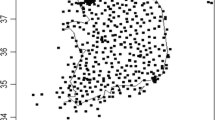Abstract
The benefits of accurately interpolating spatial distribution patterns of precipitation and temperature are well recognized. However, precipitation and temperature patterns are difficult to understand in a region that has complex topography and poor meteorological information. In this study, geostatistical and deterministic interpolation methods are used to understand the best modeling approach for mapping precipitation and temperature in a data-scarce arid region of Pakistan, where elevation and climate vary widely within a short distance. Long-term climate data collected from 15 metrological stations distributed over the Balochistan province of Pakistan are used for this purpose. The performances of various deterministic and geostatistical methods are assessed by using root mean squared errors in interpolation. The results show a difference in accuracy among interpolation methods. Incorporation of elevation significantly improves the accuracy of the interpolation of climate variables. The study concluded that the most preferable models for reliable mapping of precipitation and temperature for such region are disjunctive and universal cokriging.





Similar content being viewed by others
References
Ashiq M, Zhao C, Ni J, Akhtar M (2010) GIS-based high-resolution spatial interpolation of precipitation in mountain–plain areas of Upper Pakistan for regional climate change impact studies. Theoret Appl Climatol 99(3–4):239–253
Attorre F, Alfo M, De Sanctis M, Francesconi F, Bruno F (2007) Comparison of interpolation methods for mapping climatic and bioclimatic variables at regional scale. Int J Climatol 27(13):1825–1843
Benavides R, Montes F, Rubio A, Osoro K (2007) Geostatistical modelling of air temperature in a mountainous region of Northern Spain. Agric For Meteorol 146(3–4):173–188
Bolstad PV, Swift L, Collins F, Régnière J (1998) Measured and predicted air temperatures at basin to regional scales in the southern Appalachian mountains. Agric For Meteorol 91(3–4):161–176
Bostan PA, Heuvelink GBM, Akyurek SZ (2012) Comparison of regression and kriging techniques for mapping the average annual precipitation of Turkey. Int J Appl Earth Obs Geoinf 19(1):115–126. http://dx.doi.org/10.1016/j.jag.2012.04.010
Chen FW, Liu CW (2012) Estimation of the spatial rainfall distribution using inverse distance weighting (IDW) in the middle of Taiwan. Paddy Water Environ 10(3):209–222
Delbari M, Afrasiab P, Jahani S (2013) Spatial interpolation of monthly and annual rainfall in northeast of Iran. Meteorol Atmos Phys 122(1–2):103–113
Diodato N, Ceccarelli M (2005) Interpolation processes using multivariate geostatistics for mapping of climatological precipitation mean in the Sannio Mountains (southern Italy). Earth Surf Proc Land 30(3):259–268
Eldrandaly K, Abu-Zaid M (2011) Comparison of six GIS-based spatial interpolation methods for estimating air temperature in western Saudi Arabia. J Environ Inf 18(1):38–45
Erxleben J, Elder K, Davis R (2002) Comparison of spatial interpolation methods for estimating snow distribution in the Colorado Rocky Mountains. Hydrol Process 16(18):3627–3649
Gils H, Baig M (1992) Environmental profile: Balochistan, Pakistan. Land Resource and Urban Sciences Department. International Institute for Aerospace Survey and Earth Sciences: Enschede, Netherlands, p 56
GOB (2012) Climate and Rainfall of Balochistan, Pakistan. http://www.balochistan.gov.pk/index.php?option=com_content&view=article&id=37&Itemid=783. Accessed 4 Nov 2013
Hanif M, Khan AH, Adnan S (2013) Latitudinal precipitation characteristics and trends in Pakistan. J Hydrol 492:266–272
Hartkamp AD, De Beurs K, Stein A, White JW (1999) Interpolation techniques for climate variables. CIMMYT Mexico, DF
Hofstra N, Haylock M, New M, Jones P, Frei C (2008) Comparison of six methods for the interpolation of daily, European climate data. J Geophys Res Atmos 113(D21):D21110
Hussain I, Spöck G, Pilz J, Yu HL (2010) Spatio-temporal interpolation of precipitation during monsoon periods in Pakistan. Adv Water Resour 33(8):880–886
Isaaks EH, Srivastava RM (1989) Applied geostatistics. Oxford University Press, New York
Johnston K, Ver Hoef JM, Krivoruchko K, Lucas N (2003) ArcGIS 9: using ArcGIS geostatistical analyst. Esri Press, Redlands
Li J, Heap AD (2011) A review of comparative studies of spatial interpolation methods in environmental sciences: performance and impact factors. Ecol Inf 6(3–4):228–241
Meng Q, Lie Z, Borders BE (2013) Assessment of regression kriging for spatial interpolation—comparisons of seven GIS interpolation methods. Cartogr Geogr Inf Sci 40(1):28–39
Moral FJ (2010) Comparison of different geostatistical approaches to map climate variables: application to precipitation. Int J Climatol 30(4):620–631
Mutua F, Kuria D (2013) A comparison of spatial rainfall estimation techniques: a case study of Nyando River Basin. Kenya 14:2013
Prudhomme C, Reed DW (1999) Mapping extreme rainfall in a mountainous region using geostatistical techniques: a case study in Scotland. Int J Climatol 19(12):1337–1356
Stahl K, Moore RD, Floyer JA, Asplin MG, McKendry IG (2006) Comparison of approaches for spatial interpolation of daily air temperature in a large region with complex topography and highly variable station density. Agric For Meteorol 139(3–4):224–236
Szolgay J, Parajka J, Kohnová S, Hlavčová K (2009) Comparison of mapping approaches of design annual maximum daily precipitation. Atmos Res 92(3):289–307
UNESCO (1979) Aridity definition (UN documents), United Nations Educational. Scientific and Cultural Organization, New York
Webster R, Oliver MA (2008) Geostatistics for environmental scientists. Wiley, New York, pp 309–315
Willmott CJ (1982) Some comments on the evaluation of model performance. Bull Am Meteorol Soc 63(11):1309–1313
Zhang XS, Srinivasan R (2009) GIS-based Spatial precipitation estimation: a comparison of geostatistical approaches(1). J Am Water Resour Assoc 45(4):894–906
Author information
Authors and Affiliations
Corresponding author
Rights and permissions
About this article
Cite this article
Ahmed, K., Shahid, S. & Harun, S.B. Spatial interpolation of climatic variables in a predominantly arid region with complex topography. Environ Syst Decis 34, 555–563 (2014). https://doi.org/10.1007/s10669-014-9519-0
Published:
Issue Date:
DOI: https://doi.org/10.1007/s10669-014-9519-0




